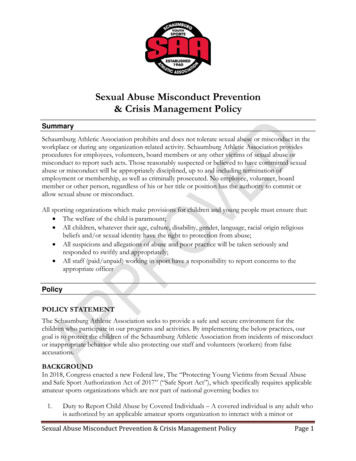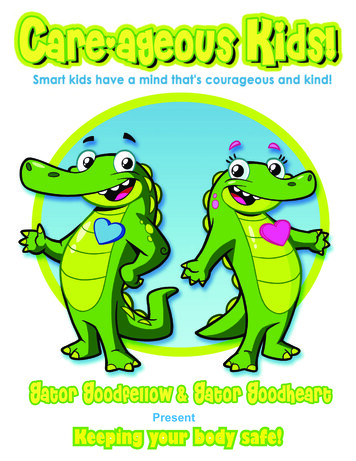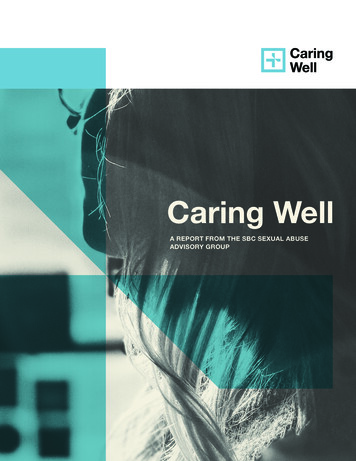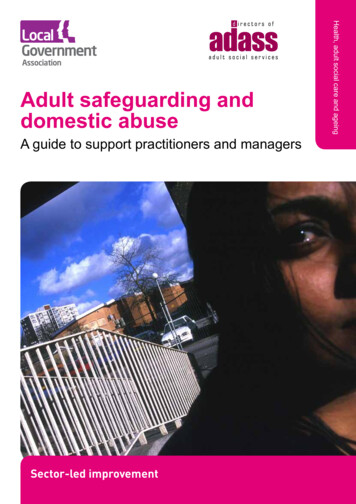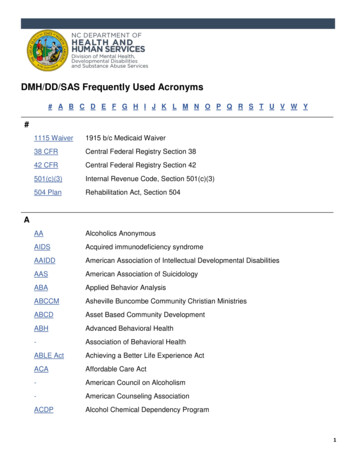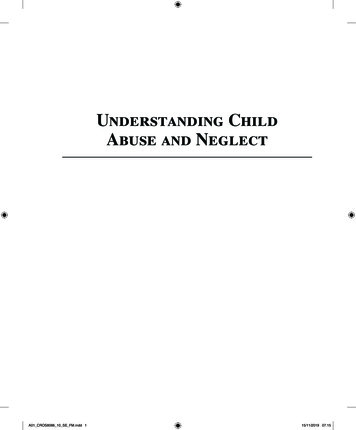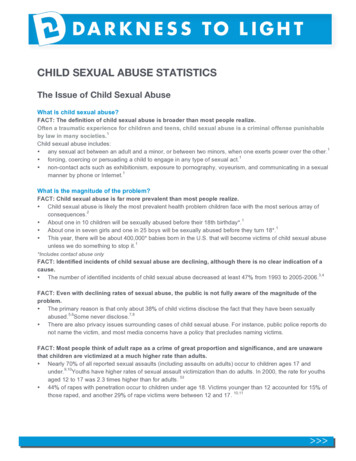
Transcription
CHILD SEXUAL ABUSE STATISTICSThe Issue of Child Sexual AbuseWhat is child sexual abuse?FACT: The definition of child sexual abuse is broader than most people realize.Often a traumatic experience for children and teens, child sexual abuse is a criminal offense punishable1by law in many societies.Child sexual abuse includes:1 any sexual act between an adult and a minor, or between two minors, when one exerts power over the other.1 forcing, coercing or persuading a child to engage in any type of sexual act. non-contact acts such as exhibitionism, exposure to pornography, voyeurism, and communicating in a sexual1manner by phone or Internet.What is the magnitude of the problem?FACT: Child sexual abuse is far more prevalent than most people realize. Child sexual abuse is likely the most prevalent health problem children face with the most serious array of2consequences.1 About one in 10 children will be sexually abused before their 18th birthday*.1 About one in seven girls and one in 25 boys will be sexually abused before they turn 18*. This year, there will be about 400,000* babies born in the U.S. that will become victims of child sexual abuse1unless we do something to stop it.*Includes contact abuse onlyFACT: Identified incidents of child sexual abuse are declining, although there is no clear indication of acause.3,4 The number of identified incidents of child sexual abuse decreased at least 47% from 1993 to 2005-2006.FACT: Even with declining rates of sexual abuse, the public is not fully aware of the magnitude of theproblem. The primary reason is that only about 38% of child victims disclose the fact that they have been sexually5,67,8abused. Some never disclose. There are also privacy issues surrounding cases of child sexual abuse. For instance, public police reports donot name the victim, and most media concerns have a policy that precludes naming victims.FACT: Most people think of adult rape as a crime of great proportion and significance, and are unawarethat children are victimized at a much higher rate than adults. Nearly 70% of all reported sexual assaults (including assaults on adults) occur to children ages 17 and9,10under. Youths have higher rates of sexual assault victimization than do adults. In 2000, the rate for youths53aged 12 to 17 was 2.3 times higher than for adults. 44% of rapes with penetration occur to children under age 18. Victims younger than 12 accounted for 15% of10,11those raped, and another 29% of rape victims were between 12 and 17.
Who are the perpetrators of child sexual abuse?FACT: Those who molest children look and act just like everyone else. There are people who have or willsexually abuse children in churches, schools and youth sports leagues.Abusers can be neighbors, friends and family members. People who sexually abuse children can be found infamilies, schools, churches, recreation centers, youth sports leagues, and any other place children gather.Significantly, abusers can be and often are other children.12,13 About 90% of children who are victims of sexual abuse know their abuser.Only 10% of sexually abused12children are abused by a stranger.12,13 Approximately 30% of children who are sexually abused are abused by family members. The younger the victim, the more likely it is that the abuser is a family member. Of those molesting a childunder six, 50% were family members. Family members also accounted for 23% of those abusing children9ages 12 to 17.12,13 About 60% of children who are sexually abused are abused by people the family trusts.15 Homosexual individuals are no more likely to sexually abuse children than heterosexual individuals.FACT: Not everyone who sexually abuses children is a pedophile.Child sexual abuse is perpetrated by a wide range of individuals with diverse motivations. It is impossible toidentify specific characteristics that are common to all those who molest children. Situational offenders tend to offend at times of stress and begin offending later than pedophilic offenders.16 They also have fewer victims (often family), and have a general preference for adult partners. Pedophilic offenders often start offending at an early age, and often have a large number of victims16(frequently not family members).14 70% of child sex offenders have between one and 9 victims, while 20% have 10 to 40 victims. FACT: As many as 40% of children who are sexually abused are abused by older, or more powerful12children. The younger the child victim, the more likely it is that the perpetrator is a juvenile. Juveniles are the offenders9in 43% of assaults on children under age six. Of these offenders, 14% are under age 12. Juveniles who commit sex offenses against other children are more likely than adult sex offenders to offend in11groups, to offend at schools, and to have more male victims and younger victims. The number of youth coming to the attention of police for sex offenses increases sharply at age 12 and14plateaus after age 14. Early adolescence is the peak age for youth offenses against younger children. A small number of juvenile offenders — one out of eight — are younger than age 12. Females constitute 7%14of juveniles who commit sex offenses.FACT: Most adolescent sex offenders are not sexual predators and will not go on to become adultoffenders. Most adolescent offenders do not meet the criteria for pedophilia and do not continue to exhibit sexually39predatory behaviors. Adolescent sex offenders are more responsive to treatment than adults. They do not appear to continue to re29offend into adulthood, especially when provided with appropriate treatment.Risk Factors and ConsequencesUnder what circumstances does child sexual abuse occur?
FACT: Child sexual abuse often takes place under specific, often surprising circumstances.It is helpful to know these circumstances because it allows for the development of strategies to avoid child sexualabuse. 81% of child sexual abuse incidents for all ages occur in one-perpetrator/one-child circumstances. Six to 119year-old children are most likely (23%) to be abused in multiple-victim circumstances. Most sexual abuse of children occurs in a residence, typically that of the victim or perpetrator – 84% for9children under age 12, and 71% for children aged 12 to 17. Sexual assaults on children are most likely to occur at 8 a.m., 12 p.m. and between 3 and 4 p.m. For older9children, aged 12 to 17, there is also a peak in assaults in the late evening hours. One in seven incidents of sexual assault perpetrated by juveniles occurs on school days in the after-school9hours between 3 and 7 p.m., with a peak from 3 to 4 pm.FACT: Commercial sexual exploitation and internet sex crimes against children are a small and yetsignificant part of the overall problem. In 2006, arrests for online youth victim cases constituted only 1.2% of arrests for all sex crimes against18children. There were 615 arrests for online cases vs. 49,345 arrests for all sex crimes against children.19 9% of all 10 to 17 year olds receive unwanted sexual requests while on the Internet. Over a period of one year, one in 25 youth received an online sexual solicitation where the solicitor tried to20make offline contact.19 23% of all 10 to 17 year olds experience unwanted exposure to pornography. Child sexual abuse makes children more vulnerable to sexual exploitation. More than 90% of children who are21commercially sexually exploited have been sexually abused in the past. About 75% of child pornography victims are living at home when they are photographed. Parents are often21responsible.FACT: Abusers often form relationships with potential victims and their families prior to the abuse. This iscalled "grooming."Grooming is a process by which an offender gradually draws a victim into a sexual relationship andmaintains that relationship in secrecy. At the same time, the offender may also fill roles within thevictim’s family that make the offender trusted and valued. Grooming behaviors can include:Special attention, outings, and giftsIsolating the child from othersFilling the child’s unmet needsFilling needs and roles within the familyTreating the child as if he or she is olderGradually crossing physical boundaries, and becoming increasingly intimate/sexualUse of secrecy, blame, and threats to maintain controlWhat factors increase a child’s risk for sexual abuse?FACT: While no child is immune, there are child and family characteristics that significantly heighten orlower risk of sexual abuse.The following risk factors are based on reported and identified cases of abuse: Family structure is the most important risk factor in child sexual abuse. Children who live with two married
biological parents are at low risk for abuse. The risk increases when children live with step-parents or a single3parent.Children living without either parent (foster children) are 10 times more likely to be sexually abused thanchildren that live with both biological parents. Children who live with a single parent that has a live-in partnerare at the highest risk: they are 20 times more likely to be victims of child sexual abuse than children living3with both biological parents.Gender is also a major factor in sexual abuse. Females are five times more likely to be abused than30males. The age of the male being abused also plays a part. 8% of victims aged 12 to 17 are male. 26% of9victims under the age of 12 are male.Age is a significant factor in sexual abuse. While there is risk for children of all ages, children are most30vulnerable to abuse between the ages of seven and 13. The median age for reported abuse is nine years319old. However, more than 20% of children are sexually abused before the age of eight.Race and ethnicity are an important factor in identified sexual abuse. African American children have almosttwice the risk of sexual abuse than white children. Children of Hispanic ethnicity have a slightly greater risk3than non-Hispanic white children.3The risk for sexual abuse is tripled for children whose parent(s) are not in the labor force.Children in low socioeconomic status households are three times as likely to be identified as a victim of child3abuse.Children who live in rural areas are almost two times more likely to be identified as victims of child sexual3abuse.32Children who witness or are the victim of other crimes are significantly more likely to be sexually abused.FACT: Family and acquaintance child sexual abuse perpetrators have reported that they look for specificcharacteristics in the children they choose to abuse. Perpetrators report that they look for passive, quiet, troubled, lonely children from single parent or broken17homes. Perpetrators frequently seek out children who are particularly trusting Find new and work proactively to51establish a trusting relationship before abusing them. Not infrequently, this extends to establishing a trusting17relationship with the victim’s family as well.What are the immediate consequences of child sexual abuse?FACT: Emotional and mental health problems are often the first consequence and sign of child sexualabuse. Children who are sexually abused are at significantly greater risk for later posttraumatic stress and 3anxiety symptoms depression and suicide attempts. These psychological problems can lead to significant disruptions in normal development and often have a35, 42,43,44,45lasting impact, leading to dysfunction and distress well into adulthood. Behavioral problems, including physical aggression, non-compliance, and oppositionality occur frequently7,54,111,112among sexually abused children and adolescents.22,47,48 Child sexual abuse has been linked to higher levels of risk behaviors.FACT: Sexual behavior problems and over-sexualized behavior are a very common consequence of childsexual abuse.Age-inappropriate behavior can be a very important and telling sign that abuse is occurring. Children who have been sexually abused have over three times as many sexual behavior problems as46children who have not been sexually abused.
Victims of child sexual abuse are more likely to be sexually promiscuous.54,55,56FACT: Academic problems in childhood are a common symptom of sexual abuse. Sexually abused children tended to perform lower on psychometric tests measuring cognitive ability,academic achievement, and memory assessments when compared to same-age non-sexually abused60cohorts. Studies indicate that sexual abuse exposure among children and adolescents is associated with high schoolabsentee rates, more grade retention1, increased need for special education services and difficulty with61school adaptation.62 39% of 7to 12-year-old girls with a history of child sexual abuse had academic difficulties. 7 to 12 year-old girls with a history of child sexual abuse were 50% more likely to display cognitive ability62below the 25th percentile. 26% of 7 to 12 year-old girls with a history of child sexual abuse reported that their grades dropped after they62were abused and 48% had below-average grades.35,61,62,63 A history of child sexual abuse significantly increases the chance of dropping out of school.FACT: Substance abuse problems beginning in childhood or adolescence are some of the most commonconsequences of child sexual abuse. A number of studies have found that adolescents with a history of child sexual abuse demonstrate a three to22,23,47,48,64fourfold increase in rates of substance abuse/dependence. Drug abuse is more common than alcohol abuse for adolescent child sexual abuse victims. Age of onset fornon-experimental drug use was 14.4 years old for victims, compared to 15.1 years old for non-victimized65youth.65 Adolescents were 2 to 3 times more likely to have an alcohol use/dependence problem than nonvictims.FACT: Delinquency and crime, often stemming from substance abuse, are more prevalent in adolescentswith a history of child sexual abuse.23,37,66,67,68,69 Adolescents who were sexually abused have a 3 to 5-fold risk of delinquency. Behavioral problems, including physical aggression, non-compliance, and oppositionality occur frequently70among sexually abused children and adolescents. These emotional and behavioral difficulties can lead to delinquency, poor school performance and dropping35,61,62,63out of school. Adolescents that reported victimization (i.e., sexual abuse or physical abuse) were more likely to be arrested66,67than their non-abused peers.66 Sexually abused children were nearly twice as likely to run away from home.FACT: The risk of teen pregnancy is much higher for girls with a history of child sexual abuse.The increased risk for pregnancy at a young age is likely due to over-sexualized behavior, another commonconsequence of child sexual abuse.40,54 Girls who are sexually abused are 2.2 times as likely as non-abused peers to become teen mothers.40 45% of pregnant teens report a history of child sexual abuse. Males who are sexually abused are more likely than their non-abused peers to impregnate a teen. In fact,several studies indicate that the sexual abuse of boys is a stronger risk factor for teen pregnancy than the59,72,83sexual abuse of girls. Most sexual abuse incidents reported by pregnant teens occurred well before the incident that resulted inpregnancy. Only 11 to 13% of pregnant girls with a history of child sexual abuse reported that they had
become pregnant as a direct result of this abuse.72What are the long-term consequences of child sexual abuse?Child sexual abuse has lasting consequences for victims. The real tragedy is that it robs children of theirpotential, setting into motion a chain of events and decisions that affect them throughout their lives.FACT: Substance abuse problems are a common consequence for adult survivors of child sexual abuse. Female adult survivors of child sexual abuse are nearly three times more likely to report substance use74problems (40.5% versus 14% in general population). Male adult CSA victims are 2.6 times more likely to report substance use problems (65% versus 25% in74general population).FACT: Mental health problems are a common long-term consequence of child sexual abuse. Adult women who were sexually abused as a child are more than twice as likely to suffer from depression as75women who were not sexually abused.76,77 Adults with a history of child sexual abuse are more than twice as likely to report a suicide attempt. Females who are sexually abused are three times more likely to develop psychiatric disorders than females78,79,80who are not sexually abused. Among male survivors, more than 70% seek psychological treatment for issues such as substance abuse,81suicidal thoughts and attempted suicide.FACT: Obesity and eating disorders are more common in women who have a history of child sexualabuse. – 24 year-old women who were sexually abused as children were four times more likely than their non82abused peers to be diagnosed with an eating disorder. Middle-aged women who were sexually abused as children were twice as likely to be obese when compared75with their non-abused peers.FACT: Child sexual abuse is also associated with physical health problems in adulthood. It is theorizedthat this is a consequence of the substance abuse, mental health issues and other consequences thatsurvivors of child sexual abuse face. Generally, adult victims of child sexual abuse have higher rates of health care utilization and report83,84,85This is truesignificantly more health complaints compared to adults without a child sexual abuse history.86for both self-reported doctor’s visits and objective examination of medical records. These health problemsrepresent a burden both to the survivor and the healthcare system.Adult survivors of child sexual abuse are at greater risk of a wide range of conditions that are non-lifethreatening and are potentially psychosomatic in nature. These include fibromyalgia, severe premenstrualsyndrome, chronic headaches, irritable bowel syndrome and a wide range of reproductive and sexual healthcomplaints, including excessive bleeding, amenorrhea, pain during intercourse and menstrual49,87,88,89irregularity.Not only do survivors of child sexual abuse have more minor health conditions, they are at greater risk formore serious conditions as well. Adults with a history of child sexual abuse are 30% more likely than theirnon-abused peers to have a serious medical condition such as diabetes, cancer, heart problems, stroke or84hypertension.Male sexual abuse survivors have twice the HIV-infection rate of non-abused males. In a study of HIV90,91infected 12 to 20 year olds, 41% reported a sexual abuse history.
FACT: Adult survivors of child sexual abuse are more likely to become involved in crime, both as aperpetrator and as a victim. This is likely a product of a higher risk for substance abuse problems andassociated lifestyle factors. Adult survivors are more than twice as likely to be arrested for a property offense than their non-abused peers66(9.3% versus 4.4%). As adults, child sexual abuse victims were almost twice as likely to be arrested for a violent offense as the66general population (20.4% versus 10.7%).81 Males who have been sexually abused are more likely to violently victimize others.Note: Although survivors of child sexual abuse are negatively impacted as a whole, it is important to realize that manyindividual survivors do not suffer these consequences. Child sexual abuse does not necessarily sentence a victim to animpaired life.Child sexual abuse has lasting consequences for societies. When the prevalence of child sexual abuse iscombined with its economic burden, the results are staggering.FACT: Child sexual abuse is a public health problem of enormous consequence. The CDC recently estimated the lifetime burden of a new substantiated of nonfatal child maltreatment to be 210,012 per victim. This includes immediate costs, as well as loss of productivity and increased healthcare92costs in adulthood. While this estimate is for all forms of child maltreatment, there is evidence that the consequences of child4sexual abuse are equivalent or greater than the consequences of other forms of child maltreatment. This estimate is comparable to that of many other high profile public health problems, indicating the impactand seriousness of the issue of child maltreatment. For example, the lifetime costs of stroke per person wereestimated at 159,846 (2010 dollars).The total lifetime costs associated with type 2 diabetes were estimated92between 181,000 and 253,000 (2010 dollars) per case.Reporting Child Sexual AbuseWhat are the reporting rates for child sexual abuse?FACT: Only about a third of child sexual abuse incidents/cases are identified, and even fewer arereported.Researchers estimate that 38% of child victims disclose the fact that they have been sexually5,67abused. Of these, 40% tell a close friend, rather than an adult or authority. These “friend-to-friend”disclosures do not always result in reports. This means that the vast majority of child sexual abuseincidents are never reported to authorities, though research suggests that disclosure rates to authorities24may be increasing. Child protective services agencies investigate about 55% of the child sexual abuse incidents reported tothem. The rest are “screened out” for lack of adequate information or for other reasons. Of those reports3investigated, only a portion meets the criteria for “substantiated.”Child protective service agencies investigate only 20% of the incidents/children identified and reported by3school personnel.School personnel identify 52% of all identified child abuse cases classified as causing harm to the child, more3than any other profession or organizational type, including child protective services agencies and the police.
Two-thirds of teachers do not receive specific training in preventing, recognizing or responding to child sexual25abuse in either their college coursework or as part of their professional development.24% of school personnel have never received any oral or written guidelines on the mandated reporting3requirements of their state.As many as 25% of child sexual abuse incidents identified by professionals not working specifically in child3protection services are not reported, despite a mandated reporting law that requires it.FACT: False reports of child sexual abuse made by children are rare.It is estimated that only 4 to 8% of child sexual abuse reports are fabricated. Most of the fabricated reports are26made by adults involved in custody disputes or by adolescents.How many child sexual abuse reports result in arrests?FACT: A large number of those arrested for child sexual assault are convicted and serve time in prison orjail.While the rate of conviction is high, arrests are made in only 29% of child sexual abuse cases and are 32% morelikely to be made in incidents involving older children. For children under six, only 19% of sexual abuse incidents9result in arrest.27 Of those charged, about 80% of rape offenders (including rapists of adults) are convicted. An estimated 48% of rape defendants (including rapes of adults) were released from detention prior to thedisposition of their case. Only defendants charged with murder had a lower rate of release (24%) than those11for whom rape charges were ending. About 14% of those convicted of rape were convicted in a jury trial, but for most defendants (82%), conviction11followed a guilty plea. The remaining 4% were convicted following a bench trial. Overall, 87% of convicted rapists (including rapists of adults) were incarcerated, and about 13% received a11sentence to probation supervision in the community. For convicted rapists sentenced to prison (not local jails), the average term imposed was just under 14 years.11An estimated 2% of convicted rapists received a term of life imprisonment. For each convicted rape offender in a prison or jail, there are nearly 3 rape offenders under probation or11parole supervision in the community.Fact: Research shows that child sexual abuse perpetrators re-offend at a lower rate than other types ofoffenders, including those convicted of rape. Rapists had a lower rate of re-arrest for a new felony and a lower rate of re-arrest for a violent felony than11,28most categories of probationers with convictions for violence.11 Released rapists were found to be 10.5 times as likely as non-rapists to be re-arrested for rape. Research suggests that incest offenders re-offend at approximately half the rate of “acquaintance” child28molesters.What do I do if I suspect or discover child sexual abuse?FACT: Signs that a child is being sexually abused are often present, but they are often indistinguishablefrom other signs of childhood stress, distress or trauma. Direct physical signs of child sexual abuse are not common. However, when physical signs are present, theymay include bruising, bleeding, redness and bumps, or scabs around the mouth, genitals, or anus. Urinarytract infections, sexually transmitted diseases, and abnormal vaginal or penile discharge are also warning33,34signs.33,34 Child sexual abuse victims often exhibit indirect physical signs, such as anxiety,chronic stomach pain and
35,36,37,38,39,40,41 headaches.Emotional and behavioral signals are common among sexually abused children. Some of these are “too33,34,35, 42,43,44,45perfect” behavior, withdrawal, fear, depression, unexplained anger and rebellion.Some common consequences of trauma include nightmares, bedwetting, falling grades, cruelty to animals,33,34bullying, being bullied, fire setting, runaway, and self-harm of any kind.One of the most telling signs that sexual abuse is occurring is sexual behavior and language that is not age33,34,46appropriate.22,23,33,34,47,48Use of alcohol or drugs at an early age can be a sign of trauma such as child sexual abuse.Note: Child sexual abuse victims may exhibit a wide range of immediate reactions, both in magnitude and form. Resilientchildren may not suffer serious consequences, whereas other children with the same experience may be highly traumatized.Some victims do not display emotional problems or any other immediate symptom in response to the abuse.FACT: Child sexual abuse reports should be made to the state’s child protective services agency, thepolice or both. Visit www.D2L.org/gethelp for more information.
REFERENCES1Townsend, C., & Rheingold, A.A., (2013). Estimating a child sexual abuse prevalence rate for practitioners: studies. Charleston, S.C.,Darkness to Light. Retrieved from www.D2L.org.2Townsend, C. (2013). Prevalence and consequences of child sexual abuse compared with other childhood experiences.Charleston, S.C., Darkness to Light. Retrieved from www.D2L.org.3Sedlak, A.J., Mettenburg, J., Basena, M., Petta, I., McPherson, K., Greene, A., and Li, S. (2010). Fourth National IncidenceStudy of Child Abuse and Neglect (NIS–4): Report to Congress, Executive Summary. Washington, DC: U.S. Department ofHealth and Human Services, Administration for Children and Families.4Finkelhor, D., & Jones, L. (2012). Have sexual abuse and physical abuse declined since the 1990s? Durham, NH: Crimesagainst Children Research Center.http://www.unh.edu/ccrc/pdf/CV267 Have%20SA%20%20PA%20Decline FACT%20SHEET 11-7-12.pdf5London, K., Bruck, M., Ceci, S., & Shuman, D. (2003) Disclosure of child sexual abuse: What does the research tell usabout the ways that children tell? Psychology, Public Policy, and Law, 11(1), 194-226.6Ullman, S. E. (2007). Relationship to perpetrator, disclosure, social reactions, and PTSD symptoms in child sexual abusesurvivors. Journal of Child Sexual Abuse, 16(1), 19-36.7Broman-Fulks, J. J., Ruggiero, K. J., Hanson, R. F., Smith, D. W., Resnick, H. S., Kilpatrick, D. G., & Saunders, B. E.(2007). Sexual assault disclosure in relation to adolescent mental health: Results from the National Survey ofAdolescents. Journal of Clinical Child and Adolescent Psychology, 36, 260 – 266.8Smith, D. W., Letourneau, E. J., Saunders, B. E., Kilpatrick, D. G., Resnick, H. S., & Best, C. L. (2000). Delay in disclosureof childhood rape: Results from a national survey. Child Abuse & Neglect, 24, 273 – 287.9Snyder, H. N. (2000). Sexual assault of young children as reported to law enforcement: Victim, incident, and offendercharacteristics. Washington, DC: U.S. Department of Justice, Office of Justice Programs, Bureau of Justice Statistics.Retrieved January 12, 2009 df10National Crime Victimization Survey, Statistic calculated by staff at Crimes against Children Research Center. 2002.11Greenfeld, L.A. (1997). Sex Offenses and Offenders An Analysis of Data on Rape and Sexual Assault. U.S. Department ofJustice, Office of Justice Programs, Bureau of Justice Statistics, NCJ-16339212Finkelhor, D. (2012). Characteristics of crimes against juveniles. Durham, NH: Crimes against Children Research Center.131415Whealin, J. (2007-05-22). “Child Sexual Abuse”. National Center for Post Traumatic Stress Disorder, US Department ofVeterans Affairs.Finkelhor, D., Ormrod,R., Chaffin, M. (2009) Juveniles who commit sex offenses against minors. Juvenile Justice Bulletin,OJJDP, Office of Justice ProgramsJenny, Carole, Roesler, Thomas A. , Poyer, Kimberly L. (1994) Are children at risk for sexual abuse byhomosexuals? Pediatrics, Vol. 94 No. 1, pp. 41-44.16Abel, G. G., Mittleman, M. S., & Becker, J. V. (1985). "Sex offenders: Results of assessment and recommendations fortreatment." In M. H. Ben-Aron, S. J. Hucker, & C. D. Webster (Eds.),Clinical Criminology: The assessment and treatmentof criminal behavior (pp. 207–220).17Elliott, M., Browne, K., & Kilcoyne, J. (1995). Child sexual abuse prevention: What offenders tell us. Child Abuse &Neglect, 5, 579-594.18Wolak, J., Finkelhor, D., Mitchell, K. (2006). Trends in
Jun 19, 2015 · biological parents are at low risk for abuse. The risk increases when children live with step-parents or a single parent.3 Children living without either parent (foster chil
